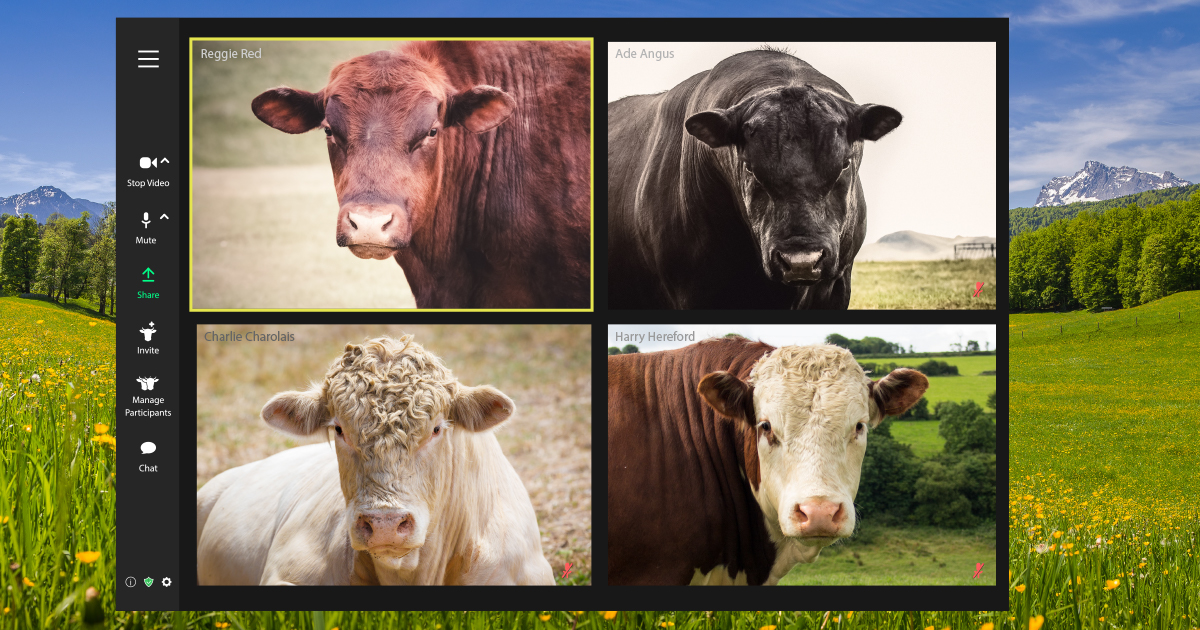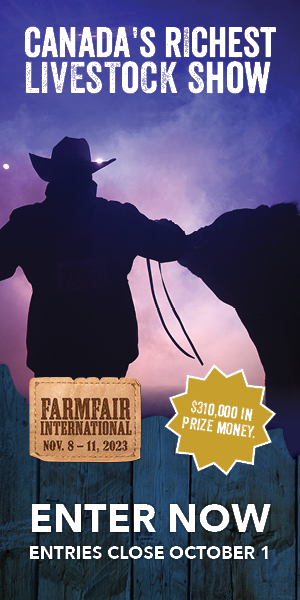AB Direct - Steers
Rail: ---
AB Direct - Heifers
Rail: ---
US Trade- Steers
Rail: 290.00 (IA)
US Trade - Heifers
Rail: 290.00 (IA)
Canadian Dollar
0.02

Virtually There: Pivoting agribusiness in a pandemic
Sure, a lot of ranch work really is pandemic friendly, like feeding cows, baling hay, fixing machinery.
But let’s face it. Raising cattle, and in fact all of agriculture, is really a people business. Time and again you will hear it’s the people, plus the animals, that make this a special way of life.
So what happens to the social aspect when the whole world goes into a lockdown? Well, there’s been a whole lot of ‘try’ for new ways of meeting, sharing information, and doing issues work.
One of the first agriculture organizations to face the challenge was Alberta Farm Animal Care, with its annual Livestock Care Conference scheduled for Olds on March 19, 2020 – just a week after the first COVID-19 related lockdown. Speakers were coming from California, Georgia and B.C.
“We had five days to switch gears to virtual, and I was so proud of the way my team made it happen,” recalls Executive Director Annemarie Pedersen.
AFAC moved the entire program to Zoom, ran the day according to its original schedule, and had three quarters of the 120 original registrants stick with the program the entire day.
“It worked and we took what we learned there and turned it into a success for our other programs,” says Pedersen.
The AFAC team was ahead of the game in the ‘work from home’ scenario since it had moved to a virtual office several months before COVID. The online learning way became a real win for many of the AFAC initiatives. The pandemic push to local food led to big interest in the group’s backyard chicken flock workshops, which reached new communities and larger groups with a virtual format. And instead of traveling to various classrooms, education on animal care was delivered to school children through the Calgary Public Library system. The ‘new ways’ proved to be important budget savers for AFAC as well.
Watching the online preferences change, Pedersen says they’re modifying again with plans for this year’s Livestock Care Conference.
“We felt another ‘marathon day’ wasn’t where we wanted to be this time, so we’re switching to a ‘lunch and learn’ approach, offering noon hour sessions twice a week during the month of March, to build in that flexibility.”
Dollars and Sense
The economics of the switch to virtual aren’t always clear-cut. Take for instance the Alberta Beef Producers. When it became apparent an online format was the only real option for the fall round of meetings, a Town Hall session was set up, followed by two virtual resolution meetings, with participants directed into their appropriate zone as they logged on.
ABP General Manager Brad Dubeau says nearly 300 producers registered for the Town Hall, with some 200 participating. There were active discussions in the resolution sessions as well. But while Dubeau notes there were definite savings in hosting meeting costs, they were offset by the need to hire a professional election corporation to handle the official balloting process, along with the mail-out expense. And it quickly drew attention to how the ABP electorate mailing list needs to be updated, and the complexity of that process.
“We’ve already started to take steps to get the list in much better shape,” acknowledged Dubeau. “We heard the frustration with the voting process. But we also heard from producers who were pleasantly surprised the online meetings went as well as they did. We’ve learned how to do some things differently that we can implement another time.”
Facetime?
Conference planning, booking hotel space and lining up speakers from North America for a 700-person event needs to be done well in advance, according to Jennifer Brunette. So that’s why the Alberta Beef Industry Conference made an ‘early’ decision to postpone its live gathering until 2022.
“It was a tough call,” admits the Event Manager, who then faced another hurdle in coming up with an alternate approach to keep the conference top of mind for regulars.
Brunette observed the current trends for virtual ‘registration fall off’ – the difference between the numbers registering and those who actually log on to attend. As well, attendees often dwindle during lengthy virtual events.
“Knowing the demographics of the industry, they’re people typically not sitting in an office where they can log in and do something else. They’re on their feet and dealing with issues as they evolve, so running something ‘live’ didn’t seem a fit,” says Brunette.
Plus she heard people are often signing up, with the real aim of getting access to the content after its live-streamed. So she took an opposite approach and has been pre-recording presentations with key speakers, and then emailing them out and putting them on the ABIC website, one at a time, over the span of several months. And the content is free!
“Our sponsors have been amazing,” Brunette comments. “My goal this year was cost control – pay for the platform and cover the speaker costs.”
Offering sponsors the opportunity for a personalized message with the presentations enabled Brunette to still offer some thought-provoking speakers the likes of Peter Ziehan, Dr. Jack Mintz and weather expert Art Douglas. Brunette also felt it was important to offer content in a shorter time span because ‘zoom fatigue is very real’.
“Our conference is a networking event, with a program,” explains Brunette.
“Removing that ability to network and connect, you really can’t replace that in any type of virtual world. This was our best foot forward, enabling us to still cause conversations.”
Youth Lead
A great example of adapting was exhibited by members of 4-H livestock clubs in the province, who couldn’t hold their annual shows and sales in person. Clubs implemented a variety of innovative selling methods, from using auction market online services, to individual members doing videos and private deals, to clubs offering boxed beef sales. 4-H officials note most clubs were encouraged by how successful their virtual efforts were, even for the charity animals. While members are hoping to be able to show their animals live again at the end of this project year, some valuable ‘learn to do by doing’ lessons were learned that may still impact the way 4-H sales are conducted in the future.
Adopting Adapting
Parking lots full of pickup trucks at event venues were hauntingly empty, as industry landmark events moved from in-person to online. Glacier Farm Media products Ag in Motion, Farm Forum and Advancing Women in Agriculture used a specialized delivery platform and offered full programs, complete with networking ‘tables’, and virtual demonstrations and tradeshows. Agri-Trade in Red Deer was a last-minute cancellation as further restrictions scuttled carefully developed protocol measures, with both sponsors and exhibitors reluctant to take on the risk. But it was replaced by a small-scale ‘Thanks For Farming Tour’ event, which still gave a few producers a chance to kick some tires and meet in person, with specially branded caps and shields.
Canadian Western Agribition in Regina had to put off its 50th anniversary celebrations, but managed to do a virtual purebred show, with exhibitors submitting videos of their animals to vie for championships in 11 breeds. The livestock show’s suite of virtual programming included a new Top 50 Influential People in Canadian Agriculture selection.
Even political lobbying moved online as commodity groups reached out to politicians through Zoom or Teams.
Where is ‘There’?
What is evident as agriculture continues its day-to-day duties while missing out on people time is what’s always been true in the food producing world. Improvising, adapting, creating new ways of doing things are well-used tools in the toolbox that have served well in these challenging times. We’ve learned a lot, and opened up new doors for communicating that can cost less and be easier than always traveling. As well, people have been stretched in new ways in knowing what they’re capable of doing, and learning has become global, as producers explore online knowledge from afar, as well as close to home.
COVID has shifted things. In fact, when gatherings resume, there may now be expectations for offering a virtual option in addition to a live program that organizers will need to acknowledge.
However, it’s clear in the farming and ranching world, the preference for face-to-face interaction remains number one, and there’s a pent-up demand for that, even if it means no handshakes and/or wearing a mask in the coming year.
Bull Sale Season
The bull sale circuit, both spring and fall, is what many producers look forward to, for the good food, fellowship and socializing along the way to finding new herd sires for the operation.
“It’s been weighing on Dad’s and my mind since the last sale we had in February (2019),” confesses Kyle Lewis of Lewis Farms. “We wondered how we were going to do the next one if the world never got itself healed up.”
The advantage for many purebred producers is they’d already moved to the digital world.
“A lot of the changes and adaptations came last year,” says Mabel Hamilton of Belvin Angus, which already had both video and online options for buyers. “Right after our (March) sale last year, a lot moved online. Anybody who hadn’t already embraced that has been scrambling, but most did.”
With agriculture deemed an essential service, auctions have been allowed to keep going. But knowing how to do that safely, follow ever-changing protocols, and cater to the wide spectrum of comfort levels hasn’t been easy for seedstock producers. The food and hospitality aspect has been especially challenging.
Benchmark Angus did adjust its bull sale plans for COVID, moving solely online at the end of November, from the original live auction intention. Mike and Doug Munton did a lot of research on the various selling options, settling on a racehorse style timed sale with DLMS.
“It’s a very new format,” remarks Mike Munton. “We were the first animals to sell through it. We like to be a little bit different, so that was part of the thinking behind it. We liked the idea, but definitely had some nerves in wondering how it would work and how everyone would receive it.”
The sale opened for bids two days before the racehorse started. Then on sale day, the clock started ticking and bids were taken over timed intervals, until there were no more bids received on any of the bulls.
“It’s very simple in design. If someone bids, the clock resets and everybody has five minutes to look again at all the bulls and decide which bulls they want to bid on. It doesn’t close out singular bulls. It waits until there are no bids on any bulls, and then they’re all sold.”
Munton says that enables buyers to readjust their preferences and budgets from the whole field. There were lots of questions ahead of time, but Munton was pleased with the overall response to the sale, which averaged nearly $5,800 on 63 bulls. Feedback from customers indicated buyers would prefer a shorter time frame for the overall sale.
“To be sitting at a computer for two and a half hours is a totally different experience for any of our buyers.”
Muntons did find it increased their pre-sale traffic from prospective buyers and that was something Lewis had been hearing from other breeders as he prepared for the sale on their farm near Spruce Grove in late February.
“Talking to those who had fall sales, they had triple the traffic leading up to their sales and I suspect we’ll be the same way, with less people on sale day,” says Lewis.
Lewis Farms was marketing some 270 bulls at their sale, a number they felt was tough to do virtually. But videoing the sale animals was already a part of their presentation.
“In the world we’re in now, the video and picture component needs to be at the highest quality ever. People are basing way more of their decisions on that, as opposed to years before. We’ve got to do the best job we can there to stay competitive.”
Belvin Angus was also encouraging more early farm visits, and like fellow breeders, respectfully asking for serious buyers only or to limit to only one representative per outfit on sale day.
“You lose that ambience,” Hamilton concedes. “There’s nothing more satisfying than seeing the bleachers filled and hearing the excitement of a sale.”
Both Lewis Farms and Belvin Angus (at press time) were planning in-person auctions, with the now-usual sanitation and safety protocols.
“We’re nervous, I’m not gonna lie on that,” adds Lewis. “There’s just so much riding on the one day, we can’t afford to jeopardize too much.”
Grundke Family Salers had always marketed bulls off their farm near Alberta Beach, but COVID adjustments saw them mount some extra video cameras, usually used for monitoring calving, in the bull pen.
Special pass codes for the pen were provided to potential buyers, and Werner Grundke would talk to them on the phone, while Debbie would move the bulls they were interested in through the camera’s view, as they studied the papers. They found that to be an effective tool for helping buyers make selections in the farm yard, without having to leave their own homes.
They’re all just examples of good old farm ingenuity.
“Agriculture would be the epitome of anytime things are tough, we have to be innovative and try to find new and better things, and that’s what all of us are doing,” adds Munton. “We don’t have the luxury of sitting still. If we want to stay in business, we have to be creative.”
Leave a Comment
Add abpdaily.com to your home screen
Tap the menu button next to the address bar or at the bottom of your browser.
Select ‘Install’ or ‘Add to Homescreen’ to stay connected.



Share this article on
About the Author
Dianne Finstad used her ranch roots to spur on what’s become a long communications career in television, radio and writing, covering agriculture and rodeo. She’s based in the Red Deer area. She serves on boards for Lakeland College and Westerner Park, and you can find her on RFD-TV Canada’s new show Frontline Farming Canada.